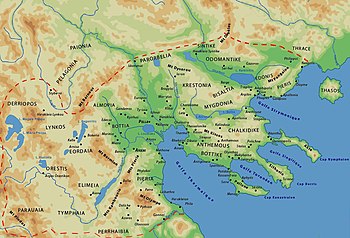
Elimiotis or Elimeia (Ancient Greek: Ἐλιμιώτις or Ἐλιμία or Ἐλίμεια) was a region of Upper Macedonia that was located along the Haliacmon river. The capital of Elimiotis was Aiani, located in the modern municipality of Kozani, Western Macedonia. It was bordered by Orestis and Eordaea in the north, Pieria in the east, Perrhaebia/Thessaly in the south and Parauaea in the west, and was inhabited by the Epirote Greek tribe of Elimiotes (Ancient Greek: Ἐλιμιῶται). In earlier times, it was independent and the Derdas family ruled the local kingdom from its capital Aiane. However, later it lost its independence and by 355 BC, Elimiotis was part of the kingdom of Macedon.
Archons of Elimiotis
- Arrhidaeus (born before 513 BC)
- Derdas I (505–435)
- Sirras (437–390)
- Derdas II (385–360)
- Derdas III (360–355), last king of Elimiotis
Notable people
- Antigonus I Monophthalmus (382-301 BC), Hellenistic ruler.
- Calas, general and satrap of Alexander the Great.
- Coenus, general of Alexander the Great.
- Cleander, officer of Alexander the Great.
- Harpalus, noble and boyhood friend of Alexander the Great.
- Machatas of Elimeia, noble of Elimiotis.
- Philip of Machatas, general of Alexander the Great.
- Polemocrates, noble of Elimiotis.
See also
Footnotes
- Fanula Papazoglu (1988). Les villes de Macédoine à l'époque romaine (in French). Vol. L'Elimiotide. Paris. pp. 245–255.
{{cite book}}: CS1 maint: location missing publisher (link) - Malkin, Irad (2001). Ancient Perceptions of Greek Ethnicity. Center for Hellenic Studies, Trustees for Harvard University. p. 163. ISBN 978-0-674-00662-1.
Hecataeus calls the Eliminiotae, Orestae, Lyncastae, and Pelagones of Uppers Macedonia 'Molossian' and since Molossian inscriptions found at the sanctuary of Dodona are inscribed in a West Greek dialect, one would expect the Macedonians to have belonged to a West Greek linguistic Koinē that extended across much of northern and northwestern Greece
- Hammond, Nicholas Geoffrey Lemprière (1982). "Chapter 40: Illyris, Epirus and Macedonia". In Boardman, John; Hammond, Nicholas Geoffrey Lemprière (eds.). The Cambridge Ancient History: The Expansion of the Greek World, Eighth to Sixth Centuries B.C. Vol. III, Part 3 (2nd ed.). Cambridge: Cambridge University Press. p. 266. ISBN 0-521-23447-6.
On crossing the Balkan chain, we find that Hecataeus called the Orestae 'a Molossian tribe' (F 107), and Strabo (434; cf. 326) probably derived from Hecataeus his belief that the Elimeotae, Lyncestae, and Pelagones, as well as the Orestae, were Epirotic or rather Molossian tribes before their incorporation by the Macedones into the Macedonian kingdom.
- Hammond, Nicholas Geoffrey Lemprière (1993). Studies Concerning Epirus and Macedonia Before Alexander. Amsterdam: Hakkert. pp. 132–133. ISBN 978-9025610500.
Further, the tribes which Strabo termed 'Epirotic' — Orestai, Tymphaioi, Elimiotai, Lynkestai and Pelagones — are likely to have spoken the same dialect as the Molossians, to whom they were in some sense related.
References
- D. C. Samsaris, Historical Geography of the Roman province of Macedonia (The Department of Western Macedonia today) (in Greek), Thessaloniki 1989 (Society for Macedonian Studies), p. 44, 69. ISBN 960-7265-01-7.
- Giuseppe, Valenza. Elamiti Elimioti Elimi Il Teatro Genealogico degli Elimi nel crocevia del Mediterraneo (in Italian). Marostica. 2022. ISBN 978-88-908854-2-6.
External links
This article about a location in ancient Macedonia is a stub. You can help Misplaced Pages by expanding it. |